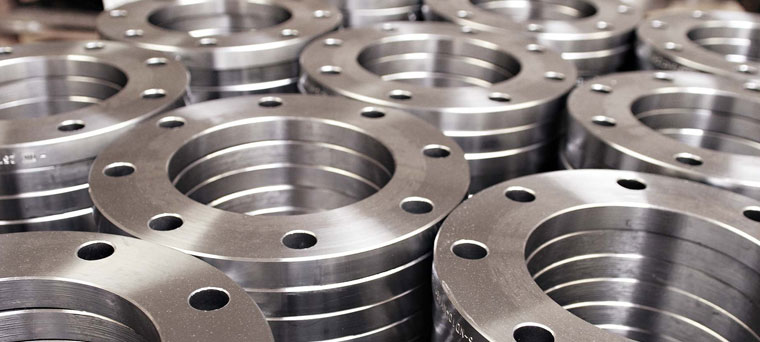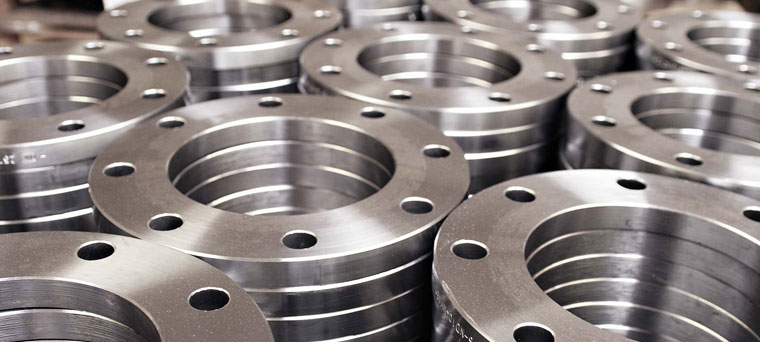
Key Features of Steel Flanges:
- High Strength: Steel flanges are known for their robust strength, which is crucial in maintaining the integrity of high-pressure systems.
- Corrosion Resistance: Steel, especially stainless steel, provides resistance to rust, corrosion, and wear, making these flanges ideal for both harsh and industrial environments.
- Variety of Types and Sizes: Steel flanges are available in various designs (e.g., weld neck, slip-on, blind) and sizes, allowing them to accommodate different pipe diameters and configurations.
- Durability: Steel flanges can withstand both high-pressure and high-temperature conditions, ensuring the longevity of piping systems.
- Versatility: These flanges are used in a wide range of applications, from plumbing and HVAC systems to more demanding industrial setups.
Types of Steel Flanges:
Steel flanges come in several types, each suited for different kinds of applications. Here are the most common types of steel flanges:- Weld Neck Flange (WN Flange):
- This flange has a long neck that is welded to the pipe. It is suitable for high-pressure systems due to its strong and reliable connection. The neck distributes the pressure evenly along the pipe, reducing stress at the weld.
- Applications: High-pressure systems, steam lines, and critical applications.
- Slip-On Flange (SO Flange):
- A slip-on flange slides over the pipe and is welded at both the top and bottom, making it easy to install. It is often used in systems where welding and installation need to be simplified.
- Applications: Low to medium-pressure applications, easy to install systems, or systems with a short service life.
- Blind Flange:
- A blind flange is used to close the end of a pipe. It has no hole in the center and is often used to seal off the end of a pipeline, vessel, or other system component.
- Applications: Temporary sealing, maintenance, or for closing off sections of piping systems.
- Socket Weld Flange (SW Flange):
- Similar to the slip-on flange but designed for smaller pipe diameters, socket weld flanges are typically used for high-pressure systems. The pipe fits into the socket, which is then welded.
- Applications: High-pressure, small-diameter piping systems.
- Threaded Flange (TF Flange):
- This flange is threaded on the inside to match the outside thread of a pipe. No welding is required, making it suitable for systems where welding is not possible.
- Applications: Low-pressure systems, where welding is not an option or where the flanges need to be removed or replaced frequently.
- Lap Joint Flange (LJ Flange):
- This flange is designed to be used with a stub end, making it easier to disassemble and reassemble piping systems. The lap joint flange itself is not welded to the pipe but instead slides over the stub end.
- Applications: Systems that need to be disassembled frequently or are subject to vibration and thermal expansion.
- Raised Face Flange (RF Flange):
- This type of flange has a raised portion around the bore, which helps concentrate the sealing pressure on the gasket, ensuring a more effective seal.
- Applications: Widely used in medium- to high-pressure applications, especially in the oil and gas industry.
- Flat Face Flange (FF Flange):
- Unlike the raised face flange, the flat face flange has a completely flat sealing surface. It is used with gaskets that are designed to create a seal without relying on a raised face.
- Applications: Low-pressure systems and systems with specific gasket requirements.
- Orifice Flange:
- This is a special type of flange used for measuring flow rates in pipes. It has two pressure taps for measuring upstream and downstream pressure, and it typically connects with orifice plates.
- Applications: Flow measurement systems, particularly in industries like oil and gas.
Materials Used in Steel Flanges:
Steel flanges can be made from various materials depending on the requirements of the application:- Carbon Steel Flanges:
- Commonly used in general-purpose systems, carbon steel flanges are cost-effective and suitable for low- to medium-pressure applications. They may require additional coatings to improve corrosion resistance.
- Stainless Steel Flanges:
- Stainless steel flanges are highly resistant to corrosion and are ideal for use in industries that deal with corrosive materials, such as chemicals, food processing, and marine environments.
- Popular grades include 304, 316, and 321 stainless steel, which offer good resistance to oxidation, pitting, and stress corrosion cracking.
- Alloy Steel Flanges:
- These flanges are used in high-temperature, high-pressure, or high-stress environments. They are often made from materials like Inconel, Monel, or Hastelloy, which are designed for extreme conditions.
- Ductile Iron Flanges:
- Ductile iron flanges are used in systems where strength and resistance to wear are required, especially in wastewater, sewage, and other industrial piping systems.
- Nickel Alloy Flanges:
- Nickel alloy flanges are used in highly corrosive environments, including chemical plants and power plants. They can resist high levels of heat and corrosion from both acids and alkalis.
Common Applications of Steel Flanges:
- Oil and Gas Industry: Steel flanges are widely used to connect pipelines that transport oil, gas, and other fluids, as well as in refineries, drilling rigs, and offshore platforms.
- Chemical Processing: The durability and corrosion resistance of steel flanges make them ideal for use in chemical plants, where pipes often carry corrosive fluids.
- Power Plants: Steel flanges are used to connect pipes carrying steam, water, and other fluids in thermal and nuclear power plants.
- Water Treatment: Steel flanges are used to join pipes and valves in water treatment and distribution systems, ensuring leak-free, durable connections.
- Food and Beverage: Stainless steel flanges are commonly used in sanitary applications, including food processing plants and breweries, due to their ease of cleaning and resistance to bacteria.
- HVAC Systems: Steel flanges are used in heating, ventilation, and air conditioning (HVAC) systems to connect ducts, valves, and other components.
Advantages of Steel Flanges:
- Strength and Durability: Steel flanges can withstand high pressures, temperatures, and mechanical stress, making them ideal for demanding industrial applications.
- Corrosion Resistance: Stainless steel flanges offer excellent resistance to corrosion, particularly in harsh environments.
- Versatility: With a wide range of types and sizes, steel flanges can be used in almost any application, from low-pressure plumbing systems to high-temperature industrial pipelines.
- Leak Prevention: Steel flanges create a strong, leak-proof seal when properly installed, preventing hazardous leaks in critical systems.
- Ease of Installation: Many steel flanges, such as slip-on and threaded flanges, are designed for easy installation and disassembly, which makes them convenient for maintenance and repairs.
Example Image of Steel Flanges:
This image represents a variety of steel flanges, showcasing different types such as weld neck, slip-on, and blind flanges. These are common components used across various industries for creating strong, durable pipe connections.Steel flanges are an essential part of the infrastructure in many industries, providing reliable, leak-proof connections that ensure the safe and efficient operation of piping systems. Whether you are designing a new pipeline or replacing components, choosing the right type of steel flange is crucial to the overall performance and safety of the system.
Lap Joint Flanges
Stainless steel:
ASTM A182, Astm A240
Grade:
F 304, F 304L, F 304H, F 316, F 316L, F 316Ti, F 310, F 310S, F 321, F 321H, F 317, F 347, F 347H, 904L
Size:
1/8″ NB TO 48″NB
Class:
Lap joint flanges class 150, Lap joint flanges class 300, Lap joint flanges class 400, Lap joint flanges class 600, Lap joint flanges class 900, Lap joint flanges class 1500 and Lap joint flanges class 2500


Weld Neck
Stainless steel:
ASTM A182, Astm A240
Grade:
F 304, F 304L, F 304H, F 316, F 316L, F 316Ti, F 310, F 310S, F 321, F 321H, F 317, F 347, F 347H, 904L
Size:
1/8″ NB TO 48″NB
Class:
Orifice Flange class 150, Orifice Flange class 300, Orifice Flange class 400, Orifice Flange class 600, Orifice Flange class 900, Orifice Flange class 1500 and Orifice Flange class 2500/p>
Slip on Flanges
Stainless steel:
ASTM A182, Astm A240
Grade:
F 304, F 304L, F 304H, F 316, F 316L, F 316Ti, F 310, F 310S, F 321, F 321H, F 317, F 347, F 347H, 904L
Size:
1/8″ NB TO 48″NB
Class:
Slip on Flange class 150, Slip on Flange class 300, Slip on Flange class 400, Slip on Flange class 600, Slip on Flange class 900, Slip on Flange class 1500 and Slip on Flange class 2500





